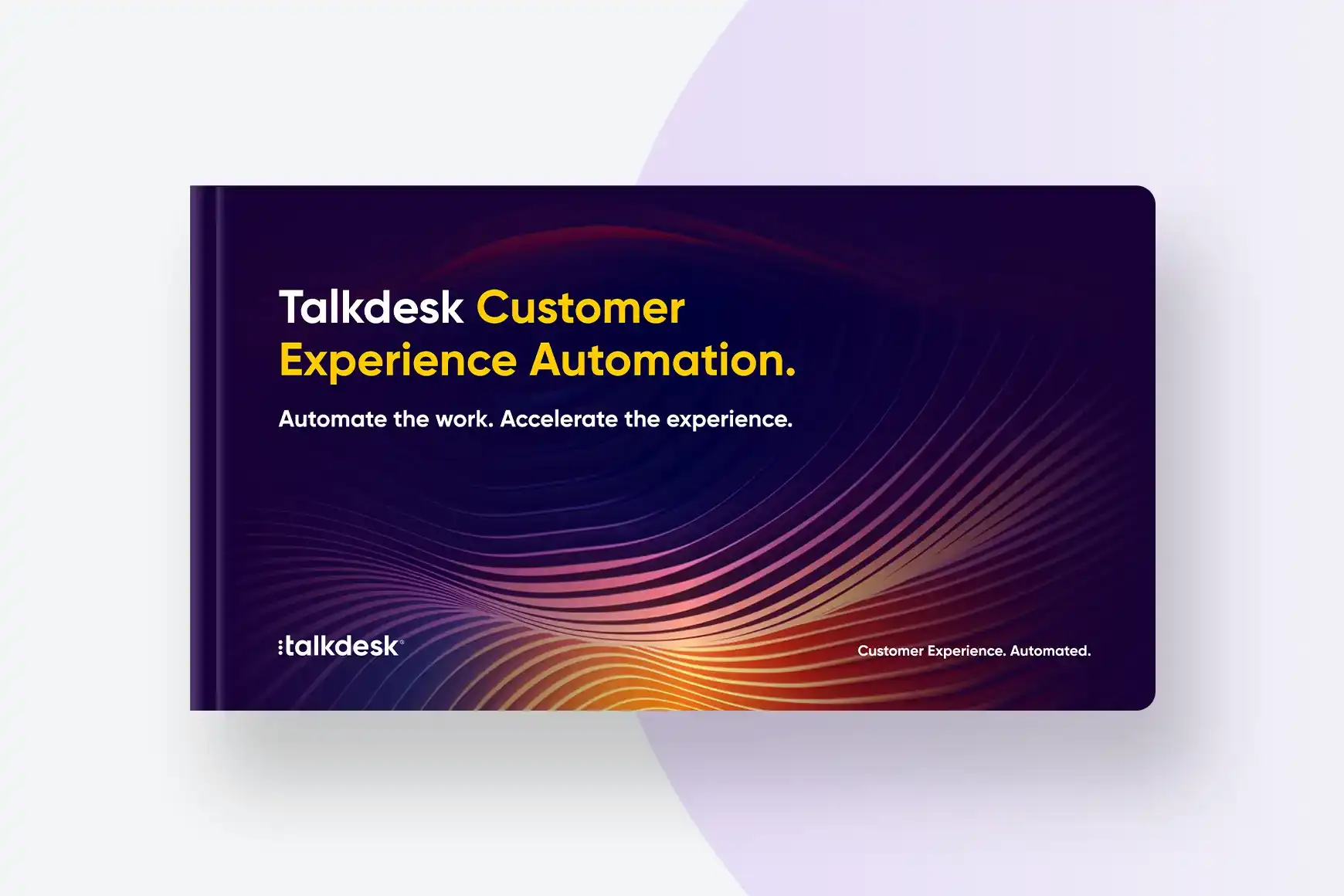Customer experience transformation: A step-by-step guide

By Celia Cerdeira
0 min read

Customer experience transformation sits at the intersection of strategy, technology, and empathy, where businesses reimagine every interaction to create lasting customer loyalty.
When businesses make customer experience a sustained priority, rather than a one-off initiative, they achieve more than satisfied customers. They see measurable gains in revenue, greater employee engagement, and stronger long-term growth. Neglect it, and the consequences are equally clear: missed opportunities, frustrated teams, and increased competition from providers offering a better experience.
In this article, we’ll walk through a step-by-step guide to customer experience digital transformation: what it means, why it matters, and how businesses can put it into practice.
What is customer experience transformation?
Customer experience transformation is the process of rethinking and reshaping how a business interacts with its customers at every stage of their journey. It goes beyond incremental improvements or isolated projects to create a holistic, customer-first strategy supported by the right tools, people, and processes.
Successful customer experience digital transformation integrates technology with human insight. By leveraging tools such as AI-powered customer experience analytics, omnichannel engagement, and automated workflows, businesses can streamline operations while delivering interactions that are consistent, personalized, and efficient. In doing so, CX transformation becomes a central driver of loyalty, revenue growth, and brand differentiation.

GUIDE
As teams optimize people, processes, and tools, they often create silos that add complexity and fragment the customer experience. Talkdesk CXA offers a smarter path forward—using a network of specialized AI agents to automate high-impact work across sales, service, support, and back-office operations.
Five signs that your customer experience isn’t working.
Recognizing when customer experience is falling short is the first step toward meaningful transformation. If a business is seeing any of the following, it may be time to revisit its approach:
-
Low customer retention rates. When customers choose not to return after initial purchases or engagements, it suggests that the experience does not provide enough value or differentiation to inspire loyalty. Retention challenges often translate directly into higher acquisition costs and stalled growth.
-
Increase in negative feedback. A surge in complaints across surveys, reviews, or social platforms signals that pain points are being felt widely. Persistent negative feedback can damage brand reputation and deter potential customers before they even engage.
-
Declining satisfaction metrics. Key performance indicators are often the clearest measures of customer satisfaction. Consistent declines in these scores reflect unmet expectations and can reveal systemic issues in products, services, or support.
-
Limited visibility into the customer journey. Without insight into how customers move through the buying and service lifecycle, businesses can’t identify where drop-offs, frustrations, or missed opportunities occur. This lack of visibility makes it nearly impossible to design experiences that feel seamless.
-
Slow resolution times. Lengthy delays in resolving issues create friction, increase customer frustration, and often result in lost business. In an era where customers expect near-instant support, slow response times leave a lasting negative impression.
Building a customer experience transformation roadmap: Five steps.
Customer experience transformation is most effective when approached as a structured, repeatable process. Rather than fixing isolated issues, businesses benefit from following a clear roadmap that aligns strategy, technology, and execution.
Before that roadmap begins, there is an essential “step zero”: defining business objectives. Since CX transformation touches every part of the business, it requires executive sponsorship and a shared understanding of success. Establishing a north star metric, such as net promoter score (NPS) or customer satisfaction score (CSAT), provides that clarity, ensuring each interaction can be tied back to larger business goals.
With this foundation in place, the following five-step framework shows how customer experience transformation can move from aspiration to measurable results.
1. Outline the customer journey.
The first step in any customer experience transformation initiative is to understand the customer journey in detail. Mapping these journeys allows teams to translate the broad concept of “customer experience” into specific, measurable paths that can be optimized for impact.
Each journey reflects a distinct customer objective, such as making a first purchase, renewing a contract, or seeking support. The key is to be as specific as possible. For instance, an insurance provider focusing on acquisition might examine the journey of a customer switching from another insurer, while a business focused on retention might study the renewal experience. Narrowing the scope to one defined journey makes it easier to pinpoint friction, design improvements, and measure results.
To get started, businesses should identify all journeys that connect to their primary business goals and then select one to focus on—ideally, the one most likely to drive meaningful outcomes. Because this decision often spans multiple departments, executive alignment is critical. A clearly defined journey creates a shared view of the customer’s experience and forms the blueprint for targeted, effective transformation.
2. Determine how to measure successful CX.
Defining how to measure success is one of the most critical steps in customer experience transformation. Without clear metrics, even the most well-designed initiatives lack direction and accountability. Businesses should identify a focused set of key performance indicators (KPIs) that reflect both customer sentiment and business outcomes, creating a balanced view of performance across the entire journey.
At a minimum, business leaders should track the following KPIs when measuring customer experience:
-
Customer satisfaction score (CSAT): Measures the level of customer satisfaction with a product, transaction, or interaction.
-
Net promoter score (NPS): Represents how likely a customer is to recommend a company’s product or service to others.
-
Customer effort score (CES): Tracks the level of effort required from customers to resolve a problem, request information, or complete a transaction with a company.
-
Customer lifetime value (CLV): Estimates the total revenue a customer generates over the entire relationship.
3. Collect customer feedback and interaction data.
Collecting and analyzing both behavioral data and direct feedback provides the most accurate view of customer sentiment, revealing where the experience excels, where it falls short, and where new opportunities exist. Combined with the customer journey map, this insight allows business leaders to see their business through the customer’s eyes.
The first layer of insight comes from studying customer experience analytics, which track how customers engage across channels and touchpoints. These analytics surface quantitative data, such as response times, resolution rates, or channel preferences, that help businesses identify patterns and areas of friction. In addition, interaction analytics, including sentiment analysis, reveal how customers feel during each interaction. By analyzing the language, tone, and emotion expressed in calls, chats, or messages, businesses can uncover trends that point to systemic issues or emerging needs.
Equally important is the collection of direct customer feedback through survey tools and listening programs. Well-designed surveys provide the qualitative perspective that raw data can’t capture. To maximize effectiveness, businesses should keep surveys concise, time them immediately after an interaction, and frame questions to encourage thoughtful, specific responses. For example, instead of asking “Were you satisfied with our service?”, a stronger prompt might be “What could have made your experience even better?” These kinds of questions lead to actionable insights rather than simple ratings.
4. Automate, automate, automate.
Sustaining customer experience transformation at scale requires more than process optimization; it demands customer experience automation (CXA), which enables businesses to deliver faster, more consistent, and more personalized experiences while maintaining operational efficiency.
At the core of this shift is multi-agent orchestration, where specialized AI agents collaborate on complex, interconnected processes that span systems, channels, and teams. Guided by an intelligent orchestrator, these agents identify friction, share context, and take coordinated action to resolve customer needs from start to finish, eliminating manual handoffs and reducing operational drag.
Powered by real-time reasoning and deep contextual understanding, AI agents can now manage sophisticated customer scenarios, such as resolving requests, assisting human agents, and completing processes that once required multiple departments. They don’t just respond; they anticipate, decide, and act, turning automation into proactive, intelligent execution at scale.
5. Upskill your customer support team.
No customer experience transformation can succeed without the support of the teams who deliver it every day. Customer service agents are the frontline voices of a business, shaping perceptions and influencing loyalty with every interaction. Securing their buy-in and empowering them with the right tools and training is essential for lasting transformation.
True CX transformation requires agent transformation. Business leaders can accelerate this by investing in workforce engagement management (WEM) technology that turns every agent into a high-performing, customer-focused representative. These platforms provide real-time coaching, performance insights, and skills development opportunities that help agents grow alongside evolving customer expectations.
What are the benefits of CX transformation?
When businesses align their people, processes, and technology around customer needs, the results speak for themselves. Here are some of the most significant benefits of customer experience transformation:
-
Stronger brand loyalty and differentiation. In a crowded marketplace, experience is the ultimate differentiator. Delivering consistent, high-quality interactions builds trust, strengthens emotional connection, and turns customers into advocates. When people feel valued and understood, they choose the brand over competitors time and again.
-
Higher revenue and profitability. Loyal customers not only spend more over time but also refer others, driving organic growth and lowering acquisition costs. Improved customer experiences translate directly into stronger financial performance and more predictable revenue streams.
-
Improved employee engagement. Employees equipped with the right tools, insights, and feedback feel empowered to do their best work. When they see the impact of their efforts on customer satisfaction, engagement rises, turnover drops, and service quality improves.
-
Greater operational efficiency. Automation and streamlined workflows reduce manual tasks, improve accuracy, and shorten resolution times. As friction decreases, both customers and employees benefit from smoother, faster interactions.
-
More actionable customer insights. A mature CX transformation framework produces valuable data about customer behavior, preferences, and sentiment. These insights allow businesses to anticipate needs, personalize engagement, and make better business decisions.
What are the challenges to implementing customer experience transformation—and how can organizations avoid them?
While CX transformation offers major rewards, success depends on anticipating and addressing common barriers. Consider these key pitfalls and how to avoid them:
-
Disconnected systems and channels. When customer data and communication channels operate in silos, it becomes nearly impossible to deliver a consistent experience. Unifying data and channels through an integrated CX platform or customer data solution enables seamless handoffs, contextual interactions, and a single, trusted view of the customer.
-
Resistance to change and lack of buy-in. Transformation often meets internal resistance, particularly when teams don’t understand its purpose or impact. Building a customer-centric culture starts with communication, early involvement, and ongoing training that empower employees to adapt and contribute to the organization’s transformation.
How does contact center technology streamline CX transformation?
Contact center technology is the engine behind faster, smarter customer experience transformation. By combining automation, AI, and data-driven insight, today’s contact centers empower businesses to deliver exceptional service at scale.
1. Improve the digital customer journey.
Contact centers are built to simplify and strengthen the digital customer journey. By connecting channels, systems, and data, they help businesses deliver experiences that feel seamless from start to finish—no matter how or where a customer chooses to engage.
When a customer moves from chat to voice or email, the conversation follows them. Context stays intact, so they never have to repeat information or start over. Automation and intelligent routing make it easy to connect customers with the right resource immediately, while real-time analytics dashboards reveal where digital interactions succeed and where they stall.
The result is a smoother, more intuitive journey that reduces effort for customers and agents alike and builds the kind of trust and satisfaction that turn everyday interactions into lasting relationships.
2. Implement time-saving technology to improve customer loyalty.
Customer loyalty is one of the strongest indicators of long-term business health. Loyal customers spend more, stay longer, and advocate for brands that consistently deliver great experiences. Time-saving CX technology helps make that possible. Contact center platforms use automation and AI to remove unnecessary steps, reduce wait times, and provide customers with the quick, accurate responses they expect.
3. Empower customers to solve their own problems.
Customers value speed and autonomy, and self-service technology delivers both. AI-powered self-service agents allow customers to find answers, complete tasks, and resolve common issues without waiting in line or engaging with a live agent. These solutions give customers control over their experience while freeing support teams to focus on more complex requests.
Modern self-service systems use conversational AI to guide customers through processes in a natural, intuitive way. Whether it’s filing an insurance claim, rebooking a delayed flight, or troubleshooting a connected device, intelligent virtual agents can manage the entire interaction—from understanding intent to executing resolutions across multiple systems.
4. Integrate core business systems.
Integrating core business systems—such as CRM, ERP, and billing platforms—with contact center software creates the foundation for a connected customer experience. When data flows seamlessly between front-line service channels and back-office systems, agents gain instant visibility into each customer’s history, preferences, and account details. This integration eliminates blind spots, enabling agents to deliver consistent service across every channel.
It also reduces operational friction. Automated data synchronization keeps records accurate across teams, eliminates duplicate work, and ensures that every department operates from the same source of truth.
5. Review custom reports on the CX metrics you care about most.
The best customer experience strategies are guided by data, and contact center technology makes that data easier to access and act on. Custom dashboards and real-time reports give leaders a clear view of the CX metrics that matter most, from first contact resolution (FCR) and CSAT to NPS and CES.
These insights allow businesses to spot trends, identify bottlenecks, and measure the direct impact of CX initiatives. Because the data updates in real time, leaders can make confident, informed decisions and pivot quickly if needed.
What are some good examples of CX transformation?
The best way to understand the power of customer experience transformation is to see it in action. Here are a few examples of how businesses are using CX technology to strengthen relationships and drive growth.
Arbella Insurance: 20% improvement in service levels.
Arbella Insurance, a billion-dollar property and casualty insurer serving New England, has long built its reputation on great customer service. To build on that promise, Arbella launched an ambitious CX transformation, replacing its UCaaS, CCaaS, and CRM systems in one coordinated rollout.
Powered by Talkdesk Customer Experience Automation, Arbella implemented Talkdesk Financial Services Experience Cloud for Insurance, supported by AI-driven capabilities like Talkdesk Autopilot, Talkdesk Copilot, and QM Assist. These tools streamlined workflows, automated routine tasks, and empowered Arbella’s 1,000+ employees with contextual insights that improved accuracy and responsiveness.
Within just one week, the company saw measurable results, including a 20% improvement in service levels, a 45-second reduction in average handle time, and a 3% increase in customer satisfaction (CSAT).
Rocky Brands: Automated 40% of chat interactions through AI.
Founded in 1932, Rocky Brands, Inc. is a trusted leader in footwear and apparel, known for its durable, high-performance products under labels like Rocky®, Georgia Boot®, Durango®, and The Original Muck Boot Company®.
To keep pace with growing customer expectations, Rocky Brands partnered with Talkdesk to evolve its customer experience from reactive support to proactive, AI-driven engagement. By expanding from two to more than five communication channels, including chat and SMS, the company now meets customers wherever they are, offering fast, seamless, omnichannel support.
Talkdesk CXA and Talkdesk Retail Experience Cloud have been central to this transformation. AI-powered chatbots now manage 40% of customer interactions, helping maintain an abandonment rate below 10% even during peak periods. On the agent side, real-time access to FAQ resources and intelligent tools has shortened average handle time, reduced after-call work, accelerated agent onboarding, and improved employee retention.
Ninefold: Increased productivity by 30%.
Ninefold powers customer service for a network of pest control companies, supporting more than 40,000 active customers. Acting as a centralized hub for operations while enabling local service delivery, Ninefold needed a solution that could scale efficiently and maintain consistent quality across its growing network.
By adopting Talkdesk CXA, Ninefold transformed its support model from reactive service to proactive, data-driven engagement. Automation, intelligent routing, and real-time analytics were embedded directly into daily workflows, helping agents respond faster and more effectively.
With Talkdesk Copilot, agent productivity increased by 30%, while Talkdesk Workforce Management optimized staffing and saved $25,000 through voluntary time off. Meanwhile, Talkdesk Interaction and Quality Analytics delivered powerful insights into customer sentiment and service quality, driving satisfaction scores as high as 4.9 out of 5, with 93% of interactions leaving customers feeling positive.
Level up your CX with Talkdesk.
True transformation happens when customer experience becomes a business strategy. By connecting data, AI, and automation, businesses can remove friction, anticipate customer needs, and scale service—without compromising quality or empathy. The result is greater loyalty, lower costs, and teams empowered to deliver exceptional experiences every time.
Discover how Talkdesk Customer Experience Automation (CXA) can accelerate your business’s customer experience transformation.
Customer experience transformation FAQs.
Find answers to the most common questions about customer experience transformation below.
Customer experience transformation is the process of reimagining how a business interacts with its customers across every touchpoint. It involves aligning people, processes, and technology to deliver faster, more personalized, and more consistent experiences that build long-term loyalty.
Successful CX transformation starts with defining clear goals, mapping the customer journey, and using data to identify areas for improvement. From there, organizations can implement automation, empower agents with the right tools, and continuously measure progress to refine the experience over time.
CX transformation drives measurable improvements in customer loyalty, revenue, and operational efficiency. It also strengthens employee engagement and helps brands stand out in competitive markets through consistently exceptional service.
Common challenges to improving CX include fragmented customer data, lack of alignment across teams, and resistance to organizational change. These barriers can be overcome by unifying systems, fostering a customer-first culture, and securing leadership support for CX initiatives.
Contact center and CX technologies, such as AI, automation, and integrated data platforms, enable faster resolutions, smarter insights, and more scalable operations. Learn how leading companies are using these tools to transform their customer experience in our customer stories.





